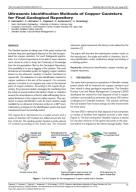Details
- Identification
- ISSN: 1977-5296, DOI: 10.3011/ESARDA.IJNSNP.2017.10
- Publication date
- 1 June 2017
- Author
- Joint Research Centre
Description
Volume: 54, June 2017, pages 75-81,
Authors: C. Clementi1,2, F. Littmann2, L. Capineri1, C. Andersson3, U. Ronneteg4
1Dept. Information Engineering – University of Florence, 2European Commission, Joint Research Centre, Nuclear Security Unit, 3Swedish Radiation Safety Authority, 4Swedish Nuclear Fuel and Waste Management Co.
Abstract:
The Swedish system for taking care of the spent nuclear fuel includes long term geological disposal of the fuel encapsulated into copper canisters. For such Safeguards applications, it is of utmost importance to be able to trace canisters once closed in order to keep the Continuity of Knowledge from the Encapsulation Plant to the Geological Repository. One possibility is to use a tagging of the canister. This work introduces an innovative system for tagging copper canisters based on the ultrasonic reading of cavities machined on copper lids. The realization of a new identification method for copper canisters is the aim of the research. For corrosion reasons it is better to not engrave any code on the external parts of copper canisters. According to the copper lid geometry, the proposed solution envisages the machining from the inside of several inclined Flat Bottom Holes or chamfers around the circumference of the lid, while still keeping the required thickness of the copper for safety reasons. They represent a unique identification code for each canister, easily readable by an ultrasonic immersion probe on a 360° scan. A laboratory prototype for the identification system has been manufactured and successfully tested.
The copper lid is reproduced on a scaled version and a series of chamfers 50° inclined are drilled around the bottom of the lid. The reading system hosted a probe placed 14° inclined according to the Snell’s law. The received ultrasonic signal represents the binary code realized by the chamfers [1].
The paper will describe the optimization studies made on the transducers, the angle and width of chamfers, the binary identification codes, preliminary design and testing of a reading system.fication (IPNDV), while taking into account the range of weapons and verification experience and the need to uphold NPT Article VI.
Keywords: ultrasound; identification; copper canister, geological repository
Reference guideline:
Clementi, C., Littmann, F., Capineri, L., Andersson, C., & Ronneteg, U. (2017). Ultrasonic Identification Methods of Copper Canisters for Final Geological Repository. ESARDA Bulletin - The International Journal of Nuclear Safeguards and Non-proliferation, 54, 75-81. https://doi.org/10.3011/ ESARDA.IJNSNP.2017.10

